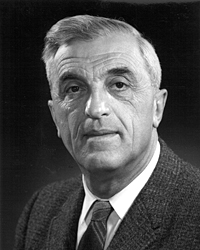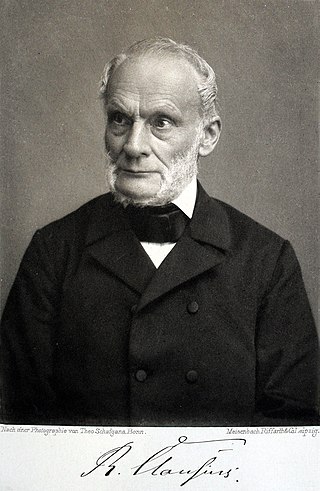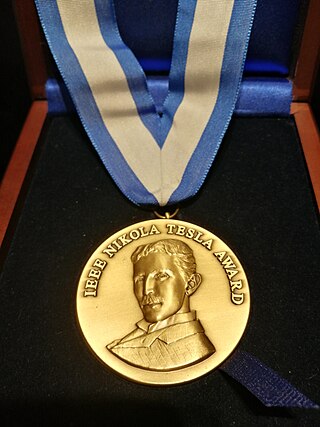ISBN 978-3-428-11204-3, pp. 587
Moritz Schröter | |
|---|---|
| Rector of the Technical University of Munich | |
| In office 1908–1911 |
ISBN 978-3-428-11204-3, pp. 587
Moritz Schröter | |
|---|---|
| Rector of the Technical University of Munich | |
| In office 1908–1911 |

Felix Bloch was a Swiss-American physicist and Nobel physics laureate who worked mainly in the U.S. He and Edward Mills Purcell were awarded the 1952 Nobel Prize for Physics for "their development of new ways and methods for nuclear magnetic precision measurements." In 1954–1955, he served for one year as the first director-general of CERN. Felix Bloch made fundamental theoretical contributions to the understanding of ferromagnetism and electron behavior in crystal lattices. He is also considered one of the developers of nuclear magnetic resonance.

Paul Julius Oswald Teichmüller was a German mathematician who made contributions to complex analysis. He introduced quasiconformal mappings and differential geometric methods into the study of Riemann surfaces. Teichmüller spaces are named after him.

Rudolf Julius Emanuel Clausius was a German physicist and mathematician and is considered one of the central founding fathers of the science of thermodynamics. By his restatement of Sadi Carnot's principle known as the Carnot cycle, he gave the theory of heat a truer and sounder basis. His most important paper, "On the Moving Force of Heat", published in 1850, first stated the basic ideas of the second law of thermodynamics. In 1865 he introduced the concept of entropy. In 1870 he introduced the virial theorem, which applied to heat.

Martin Charles Gutzwiller was a Swiss-American physicist, known for his work on field theory, quantum chaos, and complex systems. He spent most of his career at IBM Research, and was also an adjunct professor of physics at Yale University.

Ferdinand Georg Frobenius was a German mathematician, best known for his contributions to the theory of elliptic functions, differential equations, number theory, and to group theory. He is known for the famous determinantal identities, known as Frobenius–Stickelberger formulae, governing elliptic functions, and for developing the theory of biquadratic forms. He was also the first to introduce the notion of rational approximations of functions, and gave the first full proof for the Cayley–Hamilton theorem. He also lent his name to certain differential-geometric objects in modern mathematical physics, known as Frobenius manifolds.

Karl Georg Büchner was a German dramatist and writer of poetry and prose, considered part of the Young Germany movement. He was also a revolutionary and the brother of physician and philosopher Ludwig Büchner. His literary achievements, though few in number, are generally held in great esteem in Germany and it is widely believed that, had it not been for his early death, he might have joined such central German literary figures as Johann Wolfgang von Goethe and Friedrich Schiller at the summit of their profession.

Gustav Anton Zeuner was a German physicist, engineer and epistemologist, considered the founder of technical thermodynamics and of the Dresden School of Thermodynamics.

Georg Jellinek was a German public lawyer and was considered to be "the exponent of public law in Austria“.

Aurel Boleslav Stodola was a Slovak engineer, physicist, and inventor. He was a pioneer in the area of technical thermodynamics and its applications and published his book Die Dampfturbine in 1903. In addition to the thermodynamic issues involved in turbine design the book discussed aspects of fluid flow, vibration, stress analysis of plates, shells and rotating discs and stress concentrations at holes and fillets. Stodola was a professor of mechanical engineering at the Swiss Polytechnical Institute in Zurich. He maintained friendly contact with Albert Einstein. In 1892, Stodola founded the Laboratory for Energy Conversion.
Carl Eduard Cramer was a Swiss botanist.

The IEEE Nikola Tesla Award is a Technical Field Award given annually to an individual or team that has made an outstanding contribution to the generation or utilization of electric power. It is awarded by the Board of Directors of the IEEE. The award is named in honor of Nikola Tesla. This award may be presented to an individual or a team.
Klaus Paul Alfred Clusius was a German physical chemist from Breslau (Wrocław), Silesia. During World War II, he worked on the German nuclear energy project, also known as the Uranium Club; he worked on isotope separation techniques and heavy water production. After the war, he was a professor of physical chemistry at the University of Zurich. He died in Zurich.

Verena Esther Huber-Dyson was a Swiss-American mathematician, known for her work on group theory and formal logic. She has been described as a "brilliant mathematician", who did research on the interface between algebra and logic, focusing on undecidability in group theory. At the time of her death, she was emeritus faculty in the philosophy department of the University of Calgary, Alberta.

Julius Wilhelm Richard Dedekind was a German mathematician who made important contributions to number theory, abstract algebra, and the axiomatic foundations of arithmetic. His best known contribution is the definition of real numbers through the notion of Dedekind cut. He is also considered a pioneer in the development of modern set theory and of the philosophy of mathematics known as logicism.
Günter Asser was a professor emeritus of logic and mathematics at the University of Greifswald. He published numerous volumes on philosophers and mathematicians. His own research was in computability theory.

Heinrich Eduard Schröter was a German mathematician, who studied geometry in the tradition of Jakob Steiner.

Georg Joseph Sidler was a Swiss mathematician, professor at the university of Bern.

Alexander Graham Christie was a Canadian/American mechanical engineer and Professor at the Johns Hopkins University, who served as president of the American Society of Mechanical Engineers in 1939–40.

Theory and Construction of a Rational Heat Motor is an essay written by German engineer Rudolf Diesel. It was composed in 1892, and first published by Springer in 1893. A translation into English followed in 1894. One thousand copies of the German first edition were printed. In this essay, Rudolf Diesel describes his idea of an internal combustion engine based on the Carnot cycle, transforming heat energy into kinetic energy using high pressure, with a thermal efficiency of up to 73%, outperforming any steam engine of the time.

Walter Traupel was a Swiss mechanical engineer and professor at the ETH Zurich. From 1961 to 1965 he was rector of that university.